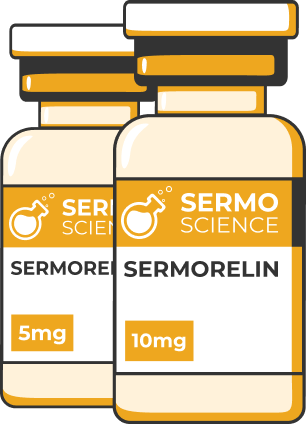- Home
How does Sermorelin Compare to Other Peptides and Compounds?
In the last couple of years, peptides have gained significant attention for their role in promoting various physiological functions, from muscle growth to anti-aging effects. Among the many peptides available, Sermorelin has appeared as a noteworthy contender, known for its capacity to stimulate the production of Human Growth Hormone (HGH) in the body.
However, the area of peptides and compounds is vast and diverse, prompting a closer examination of how Sermorelin compares to other products with a similar structure. In this blog post, we will conduct a comparative analysis and focus on the unique attributes, benefits, and applications of Sermorelin in relation to other peptides and compounds in the market.

When comparing Sermorelin to other peptides, several key factors come into play:
Mechanism of Action
Sermorelin:
Sermorelin functions as a growth hormone-releasing hormone (GHRH) analog, mimicking the action of naturally occurring GHRH in the body. By binding to specific receptors on cells in the pituitary gland, Sermorelin stimulates the synthesis and secretion of Human Growth Hormone (HGH).
Ipamorelin:
Ipamorelin is a selective growth hormone secretagogue that specifically targets and activates the ghrelin receptor. This activation leads to the release of HGH from the pituitary gland without impacting cortisol levels, promoting a controlled and sustained increase in HGH secretion.
CJC-1295:
CJC-1295 works by extending the half-life of endogenous growth hormone-releasing hormone (GHRH). By prolonging the activity of GHRH, CJC-1295 enhances the stimulation of HGH production, resulting in sustained elevation of HGH levels over an extended period.
GHRP-2 and GHRP-6:
Both GHRP-2 and GHRP-6 are growth hormone-releasing peptides that can stimulate the release of HGH through the ghrelin receptor. These peptides rapidly trigger spikes in HGH levels after administration, offering a quick but transient surge in growth hormone secretion.
Tesamorelin:
Tesamorelin is designed to specifically target and stimulate the secretion of Human Growth Hormone (HGH). Unlike some peptides primarily focused on HGH release, Tesamorelin is specifically indicated for reducing excess abdominal fat in individuals with HIV-related lipodystrophy rather than directly stimulating HGH levels.
HGH Stimulation
Sermorelin:
Sermorelin is famous for its ability to increase HGH levels gradually and naturally over time, supporting overall health and vitality without causing sudden spikes in growth hormone concentration.
Ipamorelin:
Ipamorelin offers sustained and controlled release of GH, providing a more stable elevation in HGH levels without the pronounced peaks seen with some other peptides.
CJC-1295:
Due to its long-acting nature, CJC-1295 delivers a prolonged boost in GH levels, ensuring sustained HGH secretion for an extended period after administration.
GHRP-2 and GHRP-6:
These peptides induce rapid and significant spikes in HGH levels shortly after administration, leading to a transient but potent increase in growth hormone release.
Tesamorelin:
Primarily indicated for reducing excess abdominal fat, Tesamorelin focuses on body composition changes rather than directly stimulating HGH levels, making it unique among the compared peptides.
Side Effects Profile
Understanding the potential side effects of peptides helps individuals make informed decisions regarding peptide therapy.
Sermorelin:
Tolerance: Sermorelin is typically well-tolerated by most individuals, with minimal reported side effects in clinical studies and real-world usage.
Common Side Effects: Sermorelin's few reported side effects may include mild injection site reactions like redness, swelling, or itching at the injection site. These reactions are usually transient and resolve quickly.
Ipamorelin:
Tolerance: Ipamorelin has minimal side effects in clinical studies and real-world use.
Common Side Effects: Infrequent and mild side effects may include slight injection site reactions like redness, swelling, or itching. These reactions typically resolve quickly without intervention.
CJC-1295:
Tolerance: CJC-1295 is considered safe with limited side effects when used as directed under medical supervision.
Common Side Effects: Some individuals may experience mild injection site reactions, headaches, or occasional changes in appetite. These effects are usually transient and manageable.
GHRP-2:
Tolerance: GHRP-2 is for the most part well-tolerated; however, individual responses to the peptide can vary.
Common Side Effects: Known side effects may include increased hunger, particularly following administration, and potential injection site reactions such as redness, soreness, or itching.
GHRP-6:
Tolerance: GHRP-6 can elicit stronger hunger responses compared to other peptides.
Common Side Effects: Notable for its potential to increase hunger significantly, GHRP-6 may lead to a pronounced appetite boost post-administration. Additionally, individuals may experience typical injection site reactions like redness or swelling.
Tesamorelin:
Tolerance: Tesamorelin may present unique side effect profiles based on individual characteristics.
Common Side Effects: Possible side effects include water retention, manifesting as bloating or swelling in some individuals. Injection site reactions, joint pain, or muscle aches are reported occasionally.
Dosage and Administration
Sermorelin:
Typically administered daily via subcutaneous injections to stimulate HGH release gradually.
Ipamorelin:
Requires subcutaneous injections, often administered multiple times a day for optimal results due to its shorter half-life.
CJC-1295:
Generally administered less frequently than daily due to its extended half-life, with subcutaneous injection being a common route.
GHRP-2 and GHRP-6:
Both peptides are usually administered multiple times per day to maintain consistent HGH release, commonly through subcutaneous injections.
Tesamorelin:
Administered daily via subcutaneous injections, typically used for specific indications like reducing excess abdominal fat.
Cost Considerations
Sermorelin:
Often perceived as cost-effective compared to synthetic HGH therapy, making it a more affordable option for individuals seeking HGH stimulation.
Ipamorelin:
Costs may vary based on dosage frequency and individual requirements, potentially influencing overall expenses compared to Sermorelin.
CJC-1295:
Pricing can depend on dosage schedules and product formulations, potentially affecting overall costs relative to Sermorelin.
GHRP-2 and GHRP-6:
The need for multiple administrations per day may increase the overall cost of treatment compared to Sermorelin due to higher peptide consumption.
Tesamorelin:
Cost considerations for Tesamorelin can be influenced by its specific indication for reducing abdominal fat, potentially impacting overall expenses compared to Sermorelin.